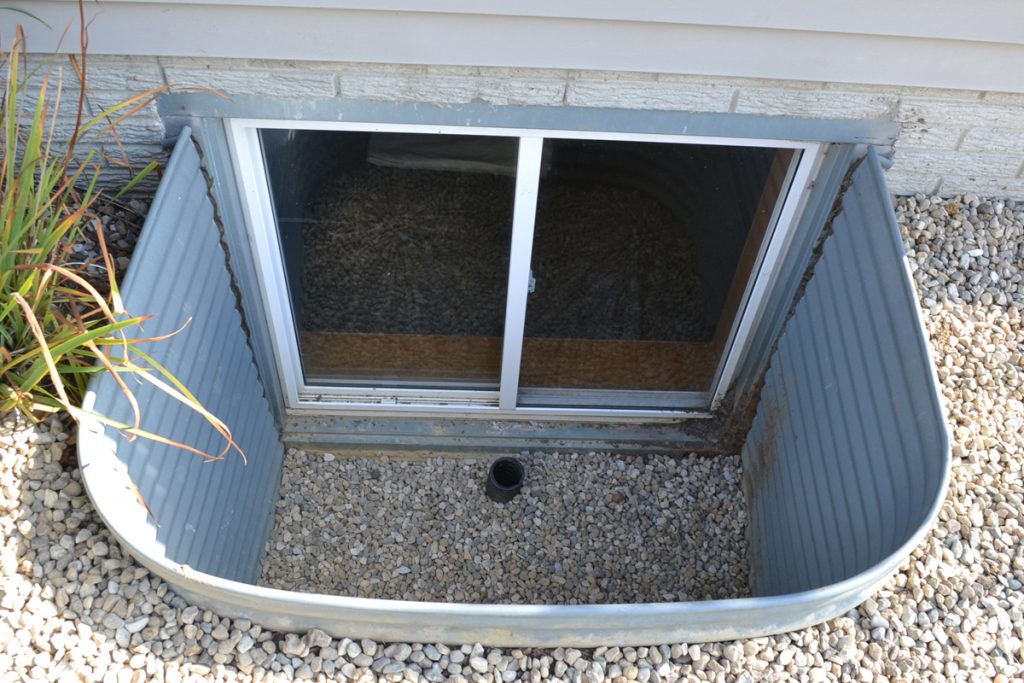Window well drainage is a subject that very few homeowners think about, until their basements flood after heavy rains. When a window well has inadequate drainage, or if it has not been installed properly, accumulated water often pours right through the basement window resulting in a flooded basement within a very short period of time.
Why Window Wells are Installed for basement windows
Window wells are typically constructed of galvanized steel; they must be installed whenever a basement window sill is at or below grade (the level of the soil adjacent to the window). The role of a window well is to prevent rainwater and surface runoff from flowing through a basement window directly into the basement.
When rainwater and/or melting snow introduce a significant amount of water in proximity to a basement window, the window well contains the water and prevents the water from flowing towards the window. It also provides drainage for the water so that the water cannot accumulate by the basement window.
The Inherent Drainage Provisions of Window Wells
For the water that does enter a window well, there are generally two drainage provisions for dealing with accumulated water: a gravel layer and a window well drain.
The gravel layer in a newly installed window well is typically 6 inches deep. In a typical window well, 36 inches wide, the window well can hold approximately 15 gallons / 54 litres of water before the water rises to a level where it will pose the threat of flooding your basement. When enhanced drainage is desired, a window well drain is installed, the top of which is generally beneath the top of the gravel layer.
Proper window well drains are 4 inches in diameter and drain the water in the window well to the weeping tile system installed underground along the footing of the foundation walls. Window well drains in new construction consist of a length of weeping tile; in retrofit applications, PVC sewer pipe is typically used.
Common Problems with Window Wells
Problems with window wells fall into four categories:
- Poor installation;
- Incorrect window well sizing;
- Gravel layer contamination; and
- Lack of adequate drainage.
Poor window well installation
A poorly installed window well is one of the major contributors to inadequate window well drainage and associated water infiltration into a basement.
In general, a poorly installed window well is not mounted flush onto the foundation wall; as a result, water and sediment enter the window well from between the foundation and the edge of the window well.
Incorrect window well sizing
Surprisingly enough, many window well problems originate with an incorrectly sized window well. In the majority of cases, the installed window well is not deep enough, occasionally it is not wide enough for the window size. We suspect this is due to the use of standard window well sizes where custom window well depths and/or widths are required. The solution to this problem is simple: replace the existing window well which is deeper, and install it properly.
Gravel layer contamination
By far, most poorly draining window wells are the result of soil and debris contamination of the gravel layer in the window well. When the gravel layer is contaminated by sediment, the excellent drainage qualities of the gravel layer are lost; similarly, leaves, newspaper and plastic bags often prevent water from reaching the gravel layer in which the water was to drain.
Inadequate window well drainage
While a galvanized window well is intended to keep water out of the window well, when water does get in it must not be allowed to accumulate; therefore, the water must drain.
Water entering a clean gravel layer will flow through to the bottom of the layer which is typically clay soil which doesn’t drain well. If little water gets into the window well, a gravel layer will provide sufficient drainage. In the event that a significant amount of water enters a window well, more robust drainage provisions are necessary. This is accomplished by installing a window well drain as shown in the illustration above. A window well drain is a very efficient way of draining substantial amounts of water to the weeping tile system.
Common window well drainage problems and recommended solutions
Problem: The window well is not deep enough and water and sediment are entering the window well cavity from beneath the galvanized window well.
Solution: Remove the existing window well and install a new window well of sufficient depth.
Problem: The window well is not fastened tightly to the foundation and sediment is entering the window well cavity from between the wall and the galvanized window well.
Solution: Re-position the existing window well and fasten it securely to the foundation.
Problem: The window well fills up with debris and clogs the drain or obstructs drainage through the gravel layer.
Solution: Install a window well cover.
Problem: The window well cannot drain quickly enough for the amount of watering getting into it.
Solution: Check the condition of the gravel layer and install a window well drain to increase drainage efficiency.
